ISSN ONLINE(2319-8753)PRINT(2347-6710)
ISSN ONLINE(2319-8753)PRINT(2347-6710)
R.Aiyshwariya Devi1 and M.Buvana2
|
| Related article at Pubmed, Scholar Google |
Visit for more related articles at International Journal of Innovative Research in Science, Engineering and Technology
Clustering is one of the important methods for prolonging the network lifetime in Mobile AD Hoc Networks. It involves grouping of nodes into clusters and electing cluster heads (CHs) for all the clusters.CHs collect the data from respective cluster’s nodes and forward the aggregated data to main node. A major challenge in MANET is to select appropriate cluster heads. In this paper, a novel fuzzy multiple criteria decision making approach, which is based on hierarchical fuzzy integral (FAHP) and Fuzzy multiple parameter decision-making (FMPDM) is introduced to optimize the selection of cluster heads to develop a distributed energy-efficient clustering algorithm. In FAHP, Single parameter is taken into account simultaneously as the main factors that can influence the selection of cluster heads while each factor contains some sub-criteria. The main Problems with single criteria are mostly based on residual energy. Doesn’t consider other information, like location of nodes, number of neighbour nodes etc. So normal nodes consumes more energy to send their data to CHs. So Fuzzy multiple parameter decision-making (FMPDM) approach is used to select CHs using three criteria including residual energy, number of neighbors, the distance from the main nodes and location. The simulation results demonstrate that this approach is more effective in maximizing the connectivity within each cluster and also localizing high intensity traffic within a cluster..
Keywords |
| MANET ,Clustering Multiple parameter decision making , fuzzy AHP,Cluster Head election ,Cluster Head |
INTRODUCTION |
| Cluster head selection is the process of selecting clusters heads In a clustering, To select an appropriate cluster head in MANET and to improve the energy efficiently using Fuzzy multiple parameter decisionmaking (FMPDM).Fuzzy multiple parameter decision making (FMPDM) is adopted to select optimal cluster heads by taking all factors into account synthetically. According to these criteria, each node computes a composite value by using fuzzy Integral. FMPDM is concerned with structuring and solving decision and planning problems involving multiple criteria. The purpose is to support decision makers facing such problems. Each group contains a single leader and several ordinary nodes. A cluster head normally serves as a local coordinator for its cluster, performing intra-cluster transmission arrangement forwarding, and so on. In the network model that we are dealing with, we assume multi-hop network, where gateway nodes connect between different clusters if there is not direct communication between the cluster heads. The clustering objectives are to minimize the total transmission power aggregated over the nodes in the selected path, and to balance the load among the nodes for prolonging the network lifetime.Clustering is one of the basic approaches for designing energy-efficient, robust and highly scalable distributed sensor networks [3]. It consists in obtaining a hierarchical organization of the network. This domain has been intensively studied because it is very useful when you want to achieve an energy-efficient message transmission through the network. |
| The cost of sending a message is higher than computation and hence it is advantageous to organize the sensors into clusters [3], where the data gathered by the sensors is communicated to the base station (BS) through a hierarchy of cluster heads (CHs). This means that creation of clusters and assigning special tasks to CHs can greatly contribute to overall system scalability, lifetime, and energy efficiency [5]. Therefore, many cluster-based algorithms have been widely studied and used. Selection of CHs, which is a pivotal step in cluster-based algorithm, can seriously influence the performance of the clustering algorithm. The âÃâ¬Ãâ¢Energy-Efficient Cluster Head Selection Scheme Based On FMPDM For MANET is proposed for optimize the selection of cluster heads to develop a distributed energy-efficient clustering algorithm.. According to this perspective, we propose an energyefficient CH selection scheme based on multiple Parameter decision making for MANET, to improve the performance of the entire network. A novel multiple parameter decision making based on trapezoidal fuzzy AHP and hierarchical fuzzy integral (FAHP) is described in detail about how to select CHs distributed in this paper. Through simulation contrasted with previous works, we show that our approach can outperform in energy efficiency and expansibility The rest of the paper is organized as follows. We review the related works in Section 2, Section 3 introduces the classification of Cluster head selection in MANET ,Section 4 introduces the FUZZY Analytical hierarchy process ,Section 5 provides Our proposed scheme FAHP with FMPDM is described in detail in.Section 6 is devoted to Extensive performance analysis. Section 7 draws conclusions and presents future directions of this study . |
RELATED WORKS |
| The objective of this work is to explore a Energy Efficient Cluster head selection scheme based on FMPDM for Mobile Ad hoc Networks. The existing clustering algorithms differ on the criteria for the selection of the CHs. According to the current research findings, the previous work about the selection method of the CHs can be summarized as follows. |
| Energy-Efficient Cluster Head Selection Scheme Based on Multiple Criteria Decision Making for Wireless Sensor Networks ,Multiple Criteria Decision making method(MCDM)trapezoidal fuzzy AHP (FAHP), and hierarchical fuzzy integral [1], have been investigated in clustering The selection of cluster heads is optimized to develop a distributed energy efficient clustering algorithm using three criteria including energy status; QOS impact and location.. Karaca et al. [19] proposed analytic hierarchy Process (AHP), which is used to centralize CH selection scheme .The factors contributing to the network lifetime are residual energy, mobility, and the distance to the involved cluster centroid. CHs are selected in each cycle based on the mobility and the remaining energy of the nodes. It is reported that the FAHP approach improves the network lifetime remarkably. |
| LEACH (Low-Energy Adaptive Clustering Hierarchy) [24] and DCHS (deterministic cluster- head selection) apply randomized rotation of the CHs to distribute the energy load among the sensor nodes evenly in the entire network. The CHs selection of them uses a probability scheme that each node determines whether it is able to be the CH only based on the random number it generated. Although the complexity of LEACH is low, the lack of energy consideration and the irregular distribution of the CHs make the algorithm energy-inefficient. |
| Heed: A Hybrid, Energy-Efficient, Distributed Clustering Approach For Ad-Hoc Sensor Networks, this paper[3] discuss about Topology control in a sensor network balances load on sensor nodes, and increases network scalability and lifetime. HEED (Hybrid Energy- Efficient Distributed clustering), that periodically selects cluster heads according to a hybrid of the node residual energy and a secondary parameter, such as node proximity to its neighbors or node degree. HEED can asymptotically almost surely guarantee connectivity of clustered networks. HEED increases Scalability, it contains Low message overhead and Uniform & nonuniform node distribution the issues are it is a complex algorithm, it needs Repeated iterations ,Decrease of residual energy and has smaller probability . |
| Mobility Based Cluster head & Gateway Selection Algorithm In MANET, it [11]discuss Mobile computing has achieved lots of attention in recent times as a variety of mobile terminals & convenient wireless connections are available. A Mobile Ad Hoc Network (MANET) is a collection of mobile nodes which interact over bandwidth confined. Because of this the network topology can change quickly and uncertain over time, each node must united within a communication routing protocol that make easier network discovery, assures message delivery, and detects failed message delivery attempts, It is Robust against synchronization errors,and it Can be used for environmental monitoring and battlefield applications,the issues are Inter cluster communication is not explained. |
| On The Selection Of Cluster Heads In MANETS, this paper [6]discuss Clustering schemes offer a practical way of providing scalability when dealing with large and dense Mobile Ad hoc Networks (MANETs).. In this paper, we investigate the problems of cluster head selection for large and dense MANETs. Two variants of the cluster head selection are examined: (1) the distanceconstrained selection where every node in the network must be located within a certain distance to the nearest cluster head; and (2) the size-constrained selection where each cluster is only allowed to have a limited number of members. It will improve the stability of cluster and it reduces the number of re-clustering,the issues are number of iterations needed for CH selection and cluster formation not mentioned. |
| An Energy Efficient Cluster Head Selection For Fault tolerant Routing In MANET,this paper [9]discuss the recent advances in Mobile Ad hoc Network (MANET) have led to many new techniques specifically designed for MANET where energy awareness is an essential consideration. In MANET, clustering is a key routing technique used to reduce energy consumption. Main objective of this type of cluster head selection is to maximize the CHs energy and also reduce single link failure in MANET. Simulation results show that our proposed model could better implement fault tolerance and prolong the lifetime of the network. It provides efficient communication between source and destination. The issues are Energy may get wasted due to long time of one cluster head action. |
| Trust-Based Cluster Head Selection Algorithm For Mobile Adhoc Networksmobile Ad Hoc Networks (MANETs) this paper[10]consist of a large number of relatively low-powered mobile nodes communicating in a network using radio signals. Clustering is one of the techniques used to manage data exchange amongst interacting nodes. Each group of nodes has one or more elected Cluster head(s), where all Cluster heads are interconnected for forming a communication backbone to transmit data.. In this paper, we propose Cluster head(s) selection algorithm based on an efficient trust model. This algorithm aims to elect trustworthy stable cluster head(s) that can provide secure communication via cooperative nodes.It provides stability, longevity and throughput. the issues are it Consumes more energy for electing the Cluster head.. |
| Cluster Head Election Techniques For Coverage Preservation In Wireless Sensor Networks, this paper[12] discuss Coverage preservation is one of the basic QOS requirements of wireless sensor networks, yet this problem has not been sufficiently explored in the context of cluster-based sensor networks.. Compared with using traditional energy-based selection methods, using coverage-aware selection of cluster head nodes, active sensor nodes and routers in a clustered sensor network increases the time during which full coverage of the monitored area can be maintained anywhere from 25% to 4.5, depending on the application scenario. |
| It increases Network scalability and Life time and Cluster heads are well balanced than LEACH. The issues are it doesn’t guarantee Optimal number of elected heads. |
| Cluster-Head Election Using Fuzzy Logic For Wireless Sensor Networks, Wireless Sensor Networks (WSNs),this paper[13] present a new generation of realtime embedded systems with limited computation, energy and memory resources that are being used in a wide variety of applications where traditional networking infrastructure is practically infeasible. Simulation shows that depending upon network configuration, a substantial increase in network lifetime can be accomplished as compared to probabilistically selecting the nodes as cluster-heads using only local information.It improves Energy efficiency and network lifetime,the issues are Instability of network and insufficient energy utilization. |
| In traditional Clustering algorithms, only residual energy is considered for cluster formation. The mobile nodes reveal their current energy level into all nodes and the node with highest energy level is taken as Cluster Head. The remaining nodes are join with the Cluster Head by sending JOIN request to their respective cluster heads. But the major challenge in Cluster Head selection is accuracy in the selection. |
| During Analysis, the issues identified are the following The lack of energy consideration and the irregular distribution of the CHs make the algorithm energyinefficient.. Lower intra-communication costs can become CHs .Cluster topology fails to achieve minimum energy consumption. Many fuzzy logic control algorithms are widely used in the CH selection. The basic elements of fuzzy logic control are fuzzifier, inference engine, Fuzzy Rule Base (FRB) and defuzzifier, as shown in Fig. 1. |
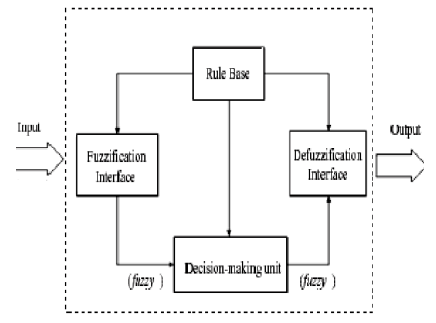 |
| Fig 1:Fuzzification process. |
| Performance measures |
| Some performance measures that are used to evaluate the performance of clustering protocols are listed below. |
| Network lifetime: It is the time interval from the start of operation (of the sensor network) until the death of the first alive node. |
| Number of cluster heads per round: Instantaneous measure reflects the number of nodes which would send directly to the sink, information aggregated from their cluster members. |
| Number of nodes per round: This instantaneous measure reflects the total number of nodes and that of each type that has not yet expended all of their energy |
| Throughput: This includes the total rate of data sent over the network, the rate of data sent from cluster heads to the sink as well as the rate of data sent from the nodes to their cluster heads. |
Classification of Cluster Head selection in MANET |
| Network selection parameters like in-network data processing, node deployment and capabilities are best described in Clustering objectives like load balancing and fault-tolerance, increased connectivity, reduced delay, minimum cluster count, maximal network longevity are also described with reference to the presented a classification of clustering attributes as clustering properties, cluster head capabilities and clustering process, our survey is based on selecting best optimized cluster head selection based on Fuzzy AHP with Multiple criteria decision making.. |
| Cluster-head Capabilities |
| The following attributes of the CH node are differentiating factors among clustering schemes: |
| • Mobility: CH may be stationary or mobile. In most cases, they are stationary. But sometimes, CHs can move within a limited region to reposition themselves for better network performance. |
| • Node Types: Generally sensor nodes among the deployed sensors are designated as CHs, but sometimes sensor nodes equipped with significantly more computation and communication resources are selected as CHs. |
| • Role: Some of the main roles of the CHs are simply relaying the traffic, aggregation or fusion of the sensed data. |
| CH Selection Criteria |
| • Initial Energy: This is an important parameter to select the CH. When any algorithm starts it generally considers the initial energy. |
| • Residual Energy: After some of the rounds are completed, the cluster head selection should be based on the energy remaining in the sensors. |
| • Energy Consumption Rate: This is another important parameter that considers the energy |
| • Average Energy of the Network: The average energy is used as the reference energy for each node. It is the ideal energy that each node should own in current round to keep the network alive. |
| CH Selection in MANET: |
| Cluster head selection is needed in cluster based Network, Must research has been done on election of cluster head in a clustering environment. In MANET ,there is no centrality to control the election process and mobility is also an issue. |
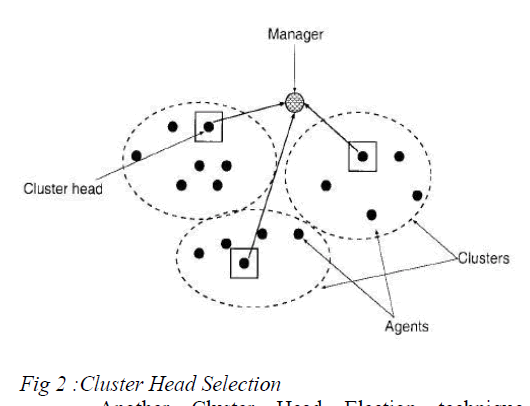 |
| Another Cluster Head Election technique was proposed based on remaining energy and relative position of the node in the cluster, the cluster head is selected on the basis of threshold value T,Threshold is calculated by the three factors Energy, Distance and Location and probability of the node, Every node generates a Random number, if it is smaller than a predefined value the node elects itself as a Cluster-head. |
| Cluster Head is selected using Fuzzy Analytical Hierarchy process(FAHP) algorithm, Cluster head elected on basis of three main factors i.e., energy, Distance and mobility, Different weights are assigned to three parameters the overall weight of every sensor node is calculated. The node having largest weight is elected as a cluster head. |
| Cluster head selection Algorithm |
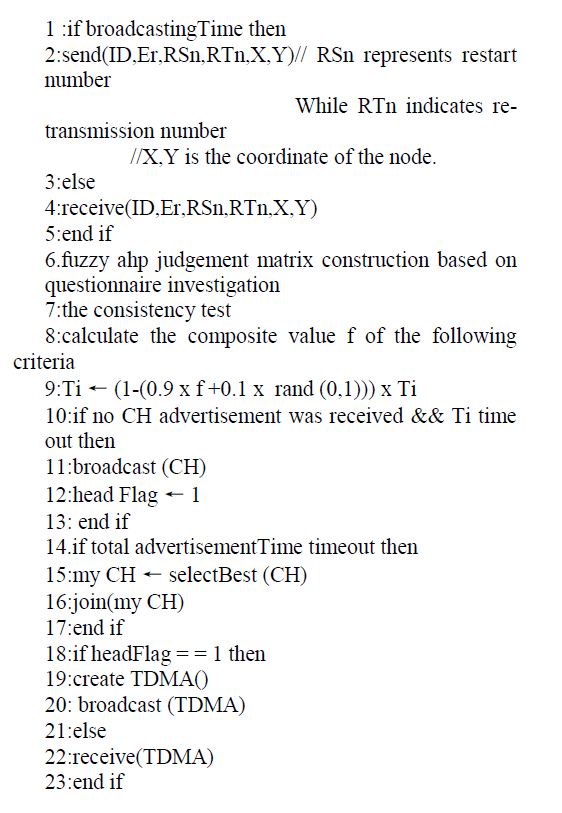 |
Fuzzy Analytical Hierarchical process |
| AHP (Analytical Hierarchy Process) [19] is a centralized CH selection scheme, which uses MCDM approach to select appropriate CHs. Residual energy, mobility and the distance to the involved cluster centroid are regarded as three criteria contributing to the network lifetime. |
| Decision Trees (DTs) which is used in Decision Support Systems, are introduced into the CH selection process. This scheme is based on four factors such as the distance of a node from the cluster centroid, the remaining battery power, the degree of mobility, and the vulnerability index. |
| In the real world, most criteria have inter-dependent or interactive characteristics. Rather than prescribing a "correct" decision, the FAHP helps decision makers find one that best suits their goal and their understanding of the problem. It provides a comprehensive and rational framework for structuring a decision problem, for representing and quantifying its elements, for relating those elements to overall goals, and for evaluating alternative solutions. |
| Users of the AHP first decompose their decision problem into a hierarchy of more easily comprehended subproblems, each of which can be analyzed independently. The elements of the hierarchy can relate to any aspect of the decision problem—tangible or intangible, carefully measured or roughly estimated, well or poorly understood—anything at all that applies to the decision at hand,In the final step of the process, numerical priorities are calculated for each of the decision alternatives. |
| FAHP generates similar overhead to the other algorithms in each round. This is a very interesting phenomenon because FAHP uses more control messages than the other algorithms, especially in all nodes broadcasting attributes information. The reason for the phenomenon above is that FAHP sends messages only at the optimal transmission power, while the maximum transmission power is used in the other algorithms, which result in excessive energy is consumed |
Fuzzy Multiple Parameter Decision Making with Fuzzy AHP |
| Multiple parameter decision Making is concerned with structuring and solving decision and planning problems involving multiple criteria. The purpose is to support decision makers facing such problems. Typically, there does not exist a unique optimal solution for such problems and it is necessary to use decision maker’s preferences to differentiate between solutions ."Solving" can be interpreted in different ways. It could correspond to choosing the "best" alternative from a set of available alternatives where "best" can be interpreted as "the most preferred alternative" of a decision maker. Another interpretation of "solving" could be choosing a small set of good alternatives, or grouping alternatives into different preference sets. An extreme interpretation could be to find all "efficient" or "nondominated" alternatives . |
| The difficulty of the problem originates from the presence of more than one criterion. There is no longer a unique optimal solution to an FMPDM problem that can be obtained without incorporating preference information. The concept of an optimal solution is often replaced by the set of nondominated solutions. |
| CH Selection Scheme Based on Multiple parameter Decision Making |
| In Multiple parameter decision making In order to achieve energy efficiency and give consideration to QOS requirements, we take the energy level, QOS status and node’s position as the main criteria. The sub-criteria are composed of residual energy, communication cost between a node and its neighbors, link quality, restart number, number of neighbors and node marginality. |
| In energy efficiency, MCDM CH selection scheme based on trapezoidal fuzzy AHP and hierarchical fuzzy integral in this paper. Three aspects and six attributes, which are likely to directly influence the network lifetime, are taken into account. The three aspects are energy status, QOS impact and node location. Each aspect includes two attributes, which are {residual energy, communication cost between a node and its neighbors}, {link quality, restart number} and {number of neighbors, node marginality}, respectively. |
| FMPDM CH selection scheme based on trapezoidal fuzzy AHP and hierarchical fuzzy integral can effectively prolong the network lifetime.To reduce inter-cluster interference, the usage of a DSSS PHY will be adopted in FAHP .Each cluster in FAHP communicates using DSSS(direct-sequence spread spectrum). |
| In this case, we propose to use the FMPDM approach based on trapezoidal fuzzy AHP and hierarchical fuzzy integral as the CH selection scheme.In proposed approach Cluster head selection is based on energy level to achieve Fault tolerance and time Synchrony problems |
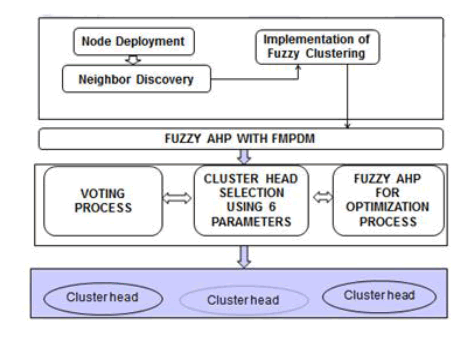 |
| Fig 3 System design |
| Node Deployment |
| In this module, the wireless sensor nodes are created. The base station node is configured with phenomenon configuration. All the sensor nodes are connected with each other using wireless link. All the nodes are randomly deployed in the network area. The sensor nodes forward their data only to base station. To establish the path between the sensor and base station nodes, routing protocols like AODV is used. |
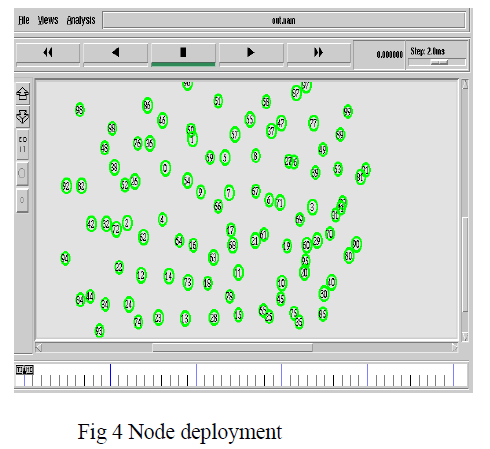 |
| IMPLEMENTATION OF FUZZY CLUSTERING |
| In this module, fuzzy clustering method is implemented. The sensor nodes are grouped into n number of clusters. Fuzzy method is used to decide the cluster members and cluster heads. All the nodes reveals their available energy to each other sensor nodes. The node which is having high residual energy than the other nodes is selected as Cluster Head (voting process). once the CH is elected, the elected node advertise his election to other nodes. The remaining nodes accepts the information and send join request to the cluster heads and becomes cluster members under their cluster heads. |
| FUZZY AHP WITH FMPDM |
| In this module, a new cluster head election mechanism is used. It combines AHP CH election technique with fuzzy clustering method. Instead of taking energy as a parameter to elect the cluster heads, our proposed method uses multiple parameters combined with fuzzy clustering mechanism. The multiple parameters that are considered are : |
| 1.Residual energy, 2.Communication cost between nodes 3. Number of neighbors, 4.Distance from the base station 5.Location of the nodes 6. Link quality. |
| This improves performance level and its cost wise beneficial than existing system. |
| According to our scheme, the node which satisfies the above said parameters can be elected as CH and the remaining nodes are joined as member nodes. |
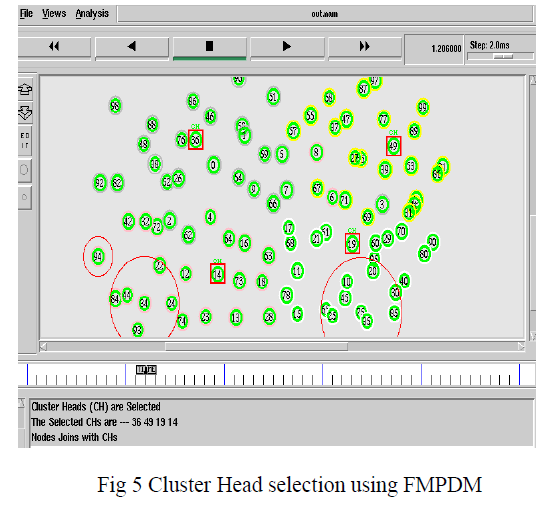 |
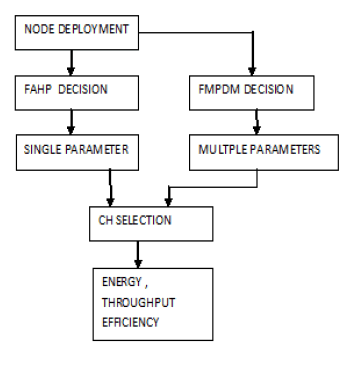 |
| Fig 6 Fuzzy AHP for Multiple parameters |
| FUZZY AHP FOR OPTIMIZATION/RESULT |
| In this module, the performance of the fuzzy clustering and fuzzy AHP with FMPDM is analyzed. Based on the analyzed results X-graphs are plotted. Throughput, delay, energy consumption are the basic parameters considered here and X-graphs are plotted for these parameters.Finally, the results obtained from this module is compared with third module results and comparison Xgraphs are plotted. Form the comparison result, final RESULT is concluded. |
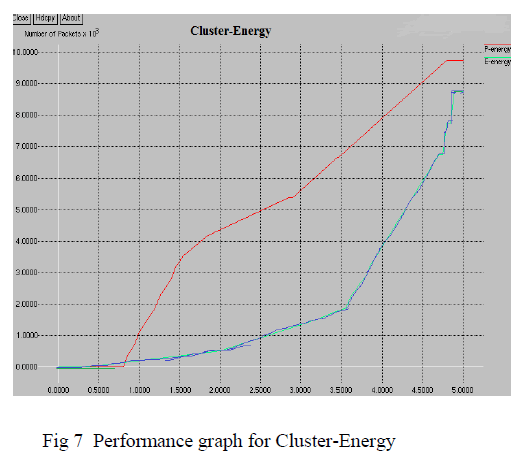 |
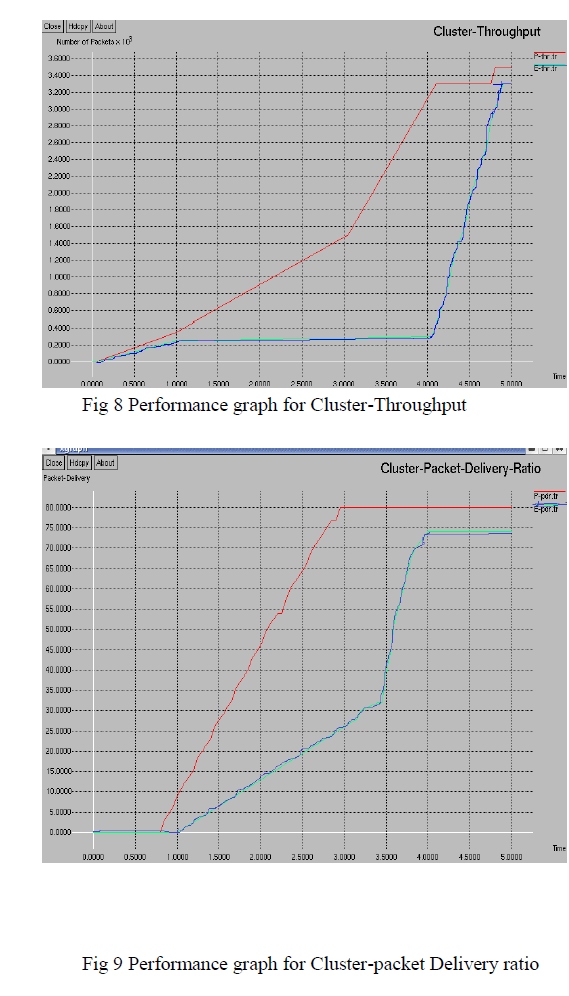 |
CONCLUSION |
| Cluster head selection scheme is an important research issue, which will also influence the operational efficiency of network, FMPDM CH selection scheme is proposed. The hierarchical fuzzy integral is introduced into the scheme in order to make the most criteria that can influence energy efficiency become a single one to determine the selection of the CHs, which is the main innovation and improvement of the classical algorithms. Moreover, the new scheme supports data fusion at CHs, which can eliminate the redundant data effectively so as to reduce the traffic and save the energy and this FMPDM is cost wise beneficial than existing algorithms, The simulation results demonstrate that the lifetime and energy efficiency of FAHP is better than other classical algorithms, time synchrony and fault tolerant problems are overcomed by using FAHP process it also improves the localization accuracy and efficiency, Classifying FAHP with FMPDM it improves Consistency of Decision making and also improves the parameters energy ,lifetime and throughput will be efficient..It also improves Robustness. |
References |
|